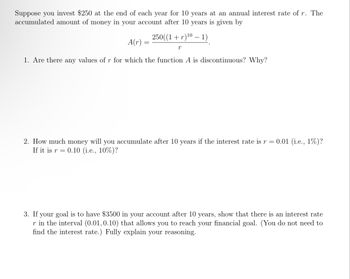
Advanced Engineering Mathematics
10th Edition
ISBN: 9780470458365
Author: Erwin Kreyszig
Publisher: Wiley, John & Sons, Incorporated
expand_more
expand_more
format_list_bulleted
Question
thumb_up100%

Transcribed Image Text:Suppose you invest $250 at the end of each year for 10 years at an annual interest rate of r. The
accumulated amount of money in your account after 10 years is given by
250((1 + r)¹⁰ − 1)
r
A(r)
1. Are there any values of r for which the function A is discontinuous? Why?
=
2. How much money will you accumulate after 10 years if the interest rate is r = 0.01 (i.e., 1%)?
If it is r= 0.10 (i.e., 10%)?
3. If your goal is to have $3500 in your account after 10 years, show that there is an interest rate
r in the interval (0.01,0.10) that allows you to reach your financial goal. (You do not need to
find the interest rate.) Fully explain your reasoning.
Expert Solution
This question has been solved!
Explore an expertly crafted, step-by-step solution for a thorough understanding of key concepts.
Step by stepSolved in 3 steps

Knowledge Booster
Similar questions
- please helparrow_forwardThe price in dollars of a house during a period of mild inflation is described by the formula P(t)=96000e^0.05t where t is the number of years after 1990. Answer the following questions: A. The value of the house in the year 2000 will be ___________ dollars. (Round your answer to the nearest dollar.) B. In the year 2000 the value will be increasing at a rate of ____________ dollars per year. (Round your answer to the nearest dollar.) C. How long will it take for a house to double in value? Answer: _____________ years. (Round your answer to two decimal places.)arrow_forwardIf $1000 is invested at 7% compounded monthly, then the future value of the investment after x years is given by the functiony = 1000(1+0.07/12)^12x,x≥0Calculate:Future value of investment after 15 years = Future value of investment after 14 years = Future value of investment after 20 months =arrow_forward
arrow_back_ios
arrow_forward_ios
Recommended textbooks for you
 Advanced Engineering MathematicsAdvanced MathISBN:9780470458365Author:Erwin KreyszigPublisher:Wiley, John & Sons, Incorporated
Advanced Engineering MathematicsAdvanced MathISBN:9780470458365Author:Erwin KreyszigPublisher:Wiley, John & Sons, Incorporated Numerical Methods for EngineersAdvanced MathISBN:9780073397924Author:Steven C. Chapra Dr., Raymond P. CanalePublisher:McGraw-Hill Education
Numerical Methods for EngineersAdvanced MathISBN:9780073397924Author:Steven C. Chapra Dr., Raymond P. CanalePublisher:McGraw-Hill Education Introductory Mathematics for Engineering Applicat...Advanced MathISBN:9781118141809Author:Nathan KlingbeilPublisher:WILEY
Introductory Mathematics for Engineering Applicat...Advanced MathISBN:9781118141809Author:Nathan KlingbeilPublisher:WILEY Mathematics For Machine TechnologyAdvanced MathISBN:9781337798310Author:Peterson, John.Publisher:Cengage Learning,
Mathematics For Machine TechnologyAdvanced MathISBN:9781337798310Author:Peterson, John.Publisher:Cengage Learning,


Advanced Engineering Mathematics
Advanced Math
ISBN:9780470458365
Author:Erwin Kreyszig
Publisher:Wiley, John & Sons, Incorporated

Numerical Methods for Engineers
Advanced Math
ISBN:9780073397924
Author:Steven C. Chapra Dr., Raymond P. Canale
Publisher:McGraw-Hill Education

Introductory Mathematics for Engineering Applicat...
Advanced Math
ISBN:9781118141809
Author:Nathan Klingbeil
Publisher:WILEY

Mathematics For Machine Technology
Advanced Math
ISBN:9781337798310
Author:Peterson, John.
Publisher:Cengage Learning,

